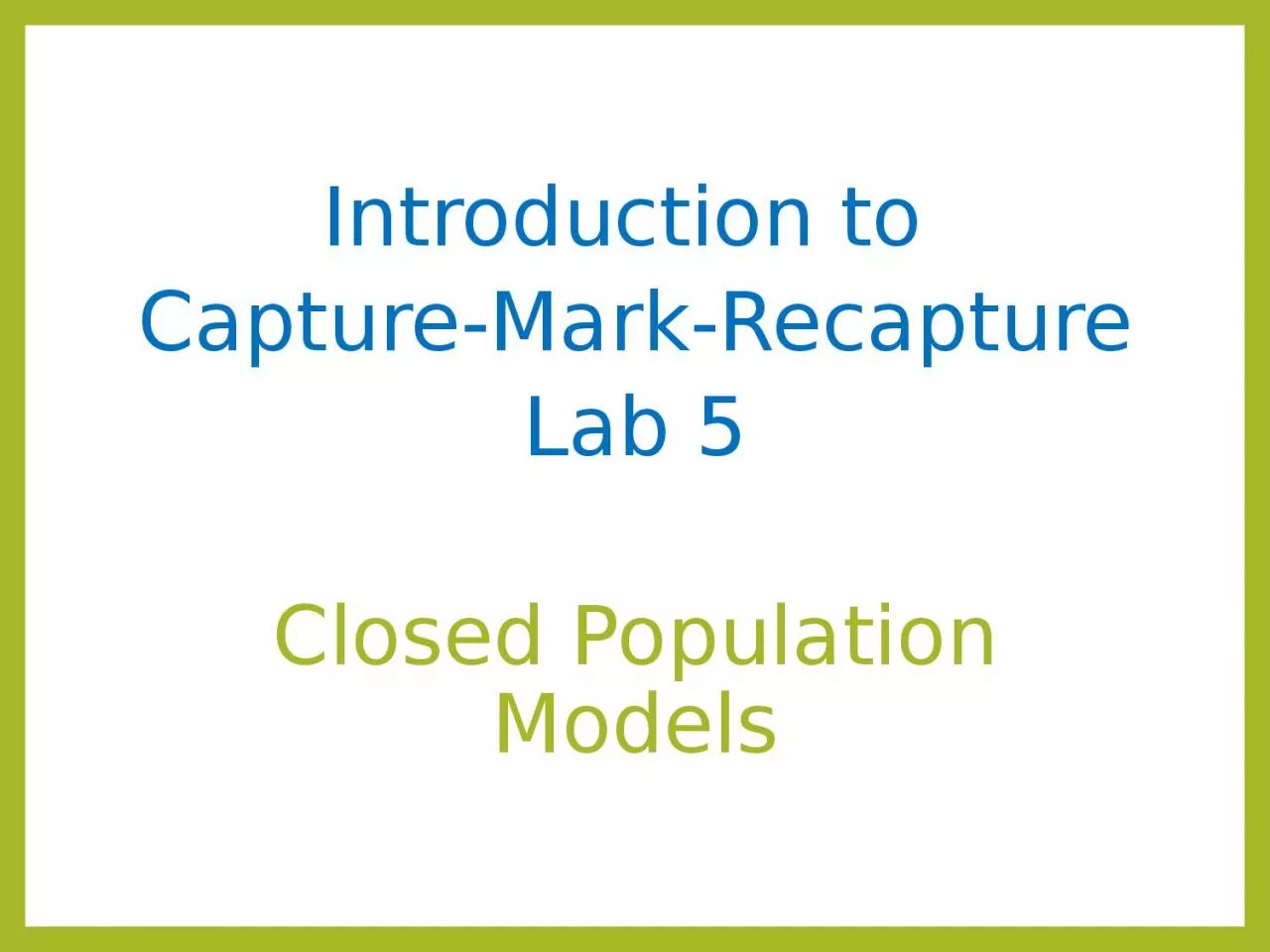

Lab 5 Closed Population Models Install program MARK Free software program for doing capture markrecapture Served out of CSU maintained by Gary White and Evan Cooch Google Program MARK httpwwwphidotorgsoftwaremarkdownloads ID: 1027988
Download Presentation The PPT/PDF document "Introduction to Capture-Mark-Recapture" is the property of its rightful owner. Permission is granted to download and print the materials on this web site for personal, non-commercial use only, and to display it on your personal computer provided you do not modify the materials and that you retain all copyright notices contained in the materials. By downloading content from our website, you accept the terms of this agreement.
1. Introduction to Capture-Mark-RecaptureLab 5Closed Population Models
2. Install program MARKFree software program for doing capture -mark-recaptureServed out of CSU, maintained by Gary White and Evan CoochGoogle “Program MARK”http://www.phidot.org/software/mark/downloads/
3. Install RMarkThis is our link to run MARK from R. So install RMark and then attach the libraryinstall.packages(“RMark”)library(RMark)#Removes all objects stored in your workspacerm(list = ls())
4. Multi-sample CMR in RMarkA capture-recapture data set on rabbits:Edwards, W.R. and L.L. Eberhardt 1967. Estimating cottontail abundance from live trapping data. J. Wildl. Manage. 31:87-96.###read in data set ###data(edwards.eberhardt)## assign the dataset a convenient name ###dat<-edwards.eberhardt
5. Looking at the data###examine the datahead(dat) ch1 0000000000000000012 0000000000000000013 0000000000000010004 0000000000000010005 0000000000000010006 000000000000001000# ch = capture history# what do you notice about the data?
6. Set up the parameters#step 1: define parameter structure#the first element defines covariates on detection #the second element defines if p and c are the samep0<-list(formula = ~1, share = TRUE) #structure for model M0pt<- list(formula=~time, share = TRUE) #structure for model Mtpb<-list(formula=~1, share = FALSE) #structure for model Mb
7. Run Model M0#model m0 - no variation in detectionm0<-mark(data=dat, model = "Closed", model.parameters = list(p = p0) ) summary(m0)
8. > summary(m0)Output summary for Closed modelName : p(~1)c()f0(~1) Npar : 2-2lnL: 375.5941AICc : 379.6029Beta estimate se lcl uclp:(Intercept) -2.416076 0.1171742 -2.645738 -2.186414f0:(Intercept) 3.008588 0.3395372 2.343095 3.674081Real Parameter p 1 2 3 4 5 6 7 8 0.081955 0.081955 0.081955 0.081955 0.081955 0.081955 0.081955 0.081955……….Real Parameter c 2 3 4 5 6 7 8 9 0.081955 0.081955 0.081955 0.081955 0.081955 0.081955 0.081955 0.081955……….Real Parameter f0 1 20.25877Add fo to the number captured (here, 76) to get the estimate of abundance = 96.258
9. Looking at the MARK output Estimates of Derived Parameters Population Estimates of { p(~1)c()f0(~1) } 95% Confidence Interval Grp. Sess. N-hat Standard Error Lower Upper ---- ----- -------------- -------------- -------------- -------------- 1 1 96.258775 6.8786049 86.603282 114.70669
10. Model Mt# model mt : p=c, but p varies with time#previously set up the function for the detection:#pt<- list(formula=~time, share = TRUE) #structure for model Mtmt<- mark(data=dat, model="Closed", model.parameters = list(p=pt))
11. Model Mb#model mb - p does not equal c#pb<-list(formula=~1, share = FALSE) #structure for model Mbmb<-mark(data=dat, model ="Closed", model.parameters = list(p=pb))
12. Model selection by AIC#automatically collects all models; mlist<-collect.models() #creates a table with model results, sorted by AICmodel.table(mlist)NOTE: When comparing models with AIC using Rmark, it is important that you check the number of parameters and that you are only comparing models that are all analyzed with the same likelihood (full vs. conditional).
13. Model Selection Table model npar AICc DeltaAICc weight Deviance4 p(~time)c()f0(~1) 19 354.5968 0.00000 9.384175e-01 305.26485 p(~time)c(~1)f0(~1) 20 360.0446 5.44779 6.157771e-02 308.65281 p(~1)c()f0(~1) 2 379.6029 25.00616 3.486397e-06 364.82592 p(~1)c(~1)f0(~1) 3 381.5498 26.95302 1.317112e-06 364.7640
14. Now onto the lab activityNote: when you want to read in your own data from a text file, you must read the data into R using the following:dat<-import.chdata(“datafile.txt", header=T)This will make your text file in the proper format for Mark to use.